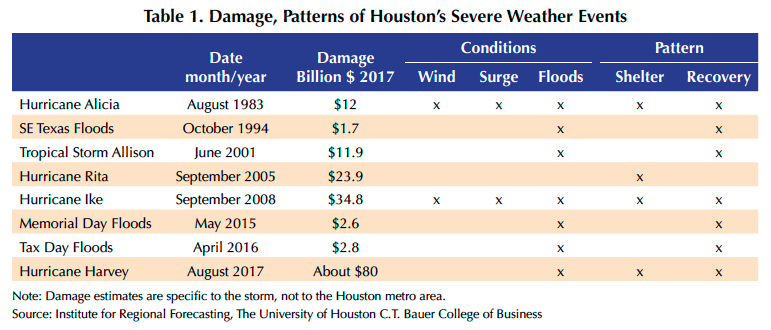
H-Town

Since 1983, eight severe weather events have each caused a billion dollars or more in damages in Houston. While the city has proven economically resilient after each storm, better flood management and infrastructure remain a challenge. |
Hurricane Harvey made its initial landfall near Rockport, Texas, about 160 miles southwest of Houston. Houston received little damage from high wind or storm surge, but as the storm stalled in warm Gulf waters, it pumped historic levels of rain into a metro area of 6.8 million people. Rains averaged 40 inches over Harris County and reached 50 inches in some areas. The Space Science and Engineering Center at the University of Wisconsin-Madison declared Harvey a 1,000-year storm with no precedent in North American history.
Moody Analytics estimated total storm damage at $81.5 billion, with Houston making up a significant share. More than 120,000 high-water rescues played for days on national television, and many commentators predicted dire consequences for Houston’s economic future. AccuWeather, for example, predicted $190 billion in property losses and that the “floodwaters and lack of electricity and basic services will put Houston into third-world-like conditions for days or weeks to come."
Predictions of economic disaster were common, but they struck economists as simply wrong. The conventional wisdom, based on many studies, is that these storms have a small and short-lived impact on measures of local income, employment, and production.
Sorting Out a Storm’s Economic Impact
The primary source of confusion about storms and the economy is property damage versus income and employment. Storm damages are a loss of wealth, a regrettable loss of capital stock that leaves people collectively poorer. These losses on the balance sheet reduce social welfare. However, an economy’s progress is measured by the income statement—the current flow of jobs, income, and production. As a storm like Harvey approaches, the population takes shelter and loses several days of work, then it emerges to an intense but short-lived boom in sectors like retail and construction. After several months, recovery activities offset losses from the shelter period.
The effects of a business cycle must be distinguished from the effects of the storms, a problem for careless analysts. Eight Houston storms have caused billions of dollars in damages, and only two of these storms have not been mixed up in significant business cycle reversals. For example, Tropical Storm Allison landed in June 2001 with the Tech Bust, and Hurricane Ike came in September 2008 with the Great Recession (see figure). In both cases, most of the large, continuing job losses were due to recession, not storms.

Hurricanes have resulted in heavy out-migration and serious economic setbacks for New Orleans and Puerto Rico. However, was this because of the storms or the lack of infrastructure in the face of severe but predictable storms? A city built below sea level with inadequate dikes will eventually suffer the consequences, as will an island that has allowed its electrical system to seriously deteriorate before the storm.
The argument that the economy is resilient assumes that the affected region is taking care of business by providing adequate storm defenses. For Houston, the lasting effect of Harvey will be the realization that after decades of rapid economic development its reservoir operations and infrastructure may be inadequate. Harvey’s warning about flooding in river systems comes on the heels of Hurricane Ike, a storm that swept over Galveston Island in 2008, demonstrating that the region’s coastal areas are dangerously exposed to storm surge. Storm-related infrastructure is about keeping the economy resilient.
Houston, Hurricanes, and Floods
According to the National Oceanic and Atmospheric Administration’s National Weather Centers for Environmental Information, eight severe weather events have each caused a billion dollars or more in damages in Houston since 1983 (Table 1). Losses are in 2017 dollars and adjusted for changes in price levels. Houston events are a mix of floods, tropical storms, and hurricanes. They bring high winds and storm surge and cause flooding in streets and along regional waterways.
During hurricanes like Alicia and Ike, a city follows the pattern of evacuation or shelter, loss of several days of work, and a brief boom in retail sales and construction. Hurricanes tend to leave a distinctive down-and-up pattern in the economic data on employment and income.

Flood events, on the other hand, catch the city by surprise with intense thunderstorms and heavy rain. Economic activity does not usually stop in the face of impending disaster, and workday routines often can resume relatively quickly after these flood events. Freshwater flooding follows more predictable and localized channels than wind or storm surge, leaving most roadways, electrical lines, and infrastructure untouched in a metro area as large as Houston. The 1994 floods and the Memorial Day and Tax Day floods all followed this pattern. The surprise comes when floods reach beyond previously established flood plains.
Three hybrid events are also listed in the table. Tropical Storm Allison, for example, came ashore with high rates of rainfall but no shelter period and only moderate winds and surge. The National Hurricane Center stopped issuing bulletins as Allison traveled north as far as Lufkin, but a return visit to Houston brought major floods. Allison’s impact was more like a flood event: no warning or shelter period, no surge, no wind, and damage mostly from fresh water.
By contrast, Rita was preceded by a significant amount of preparation and shelter-related activities throughout the Houston area, but landfall came just east of Houston with little local damage and no real recovery period. Hurricane Harvey also required Houstonians to take shelter as it approached the coast, and, like Rita, it missed the region at landfall. However, unlike Rita, Harvey landed to the west, bringing major rainfall to Houston. There were no local hurricane-force winds or storm surge, and Harvey left its mark as regional flooding.

Eight Storms and Houston’s Economy
The Institute for Regional Forecasting summarized Houston’s economic reaction to these storms using data available six months after each event (Table 2). The percentages show the net change in two economy-wide measures of Houston’s economic performance: local payroll employment and the Dallas Fed’s Business Cycle Index (BCI) for Houston. The BCI also includes payroll employment to describe economic events, along with real wages, real retail sales, and the unemployment rate. As expected, the economic changes were small. There was no storm-driven turning point in economic events.
For measures of the economy as a whole, Allison caused small negative changes to the local economy, while the effects of Alicia, the Memorial Day and Tax Day Floods, and Harvey were small but positive. Only Allison’s and Harvey’s economic impacts reached 90 percent levels of statistical significance.
Certain economic sectors, such as spending and construction activity, are stimulated in the wake of major storms. Spending was measured by local sales and use tax collections. Construction activity was measured by construction employment. Both had significant and positive impacts as repairs follow storms.
Changes in construction employment were smaller than expected, perhaps because this measure understates storm-related cleanup activity. Many contractors specializing in flood cleanup came from outside the city and weren’t counted on local payrolls. Much of the cleanup activity (mucking buildings, pulling carpet, cutting wallboard) was the work of day labor and not construction. It was also an opportunity for local construction workers to work off the books and make some tax-free income.
Houston’s economy has proven remarkably resilient in the face of eight major storms, including Harvey. In fact, Harvey was a small plus for the economy but with two key qualifications. First, the measurement comes after the write-off of $80 billion in property damage, and no one advocates a hurricane to improve social welfare. Second, adequate infrastructure for flood prevention must be in place. While Houston dodged economic disaster with Ike and Harvey, better flood management and infrastructure remain a challenge for the city.
____________________
Dr. Gilmer ([email protected]) is director with the University of Houston Bauer Institute for Regional Forecasting.

You might also like

Publications
Receive our economic and housing reports and newsletters for free.





